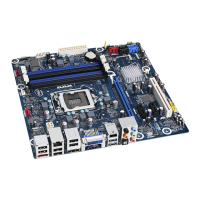Intel Desktop Board DH67GD and Intel Desktop Board DH67BL Technical Product
Specification
60
Table 36 provides maximum case temperatures for the components that are sensitive
to thermal changes. The operating temperature, current lo
ad, or operating frequency
could affect case temperatures. Maximum case temperatures are important when
considering proper airflow to cool the board.
Table 36. Thermal Considerations for Components
Component Maximum Case Temperature
Processor For processor case temperature, see processor datasheets and
processor specification updates
Intel H67 Express Chipset 111
o
C
To ensure functionality and reliability, the component is specified for proper operation
when Case Temperature is maintained at or below the maximum temperature listed in
Table 36. This is a requirement for sustained power dissipation equal to Thermal
De
sign Power (TDP is specified as the maximum sustainable power to be dissipated by
the components). When the component is dissipating less than TDP, the case
temperature should be below the Maximum Case Temperature. The surface
temperature at the geometric center of the component corresponds to Case
Temperature.
It is important to note that the temperature measurement in the system BIOS is a
value reported by embedded thermal sensors in the components and does not directly
correspond to the Maximum Case Temperature. The upper operating limit when
monitoring this thermal sensor is Tcontrol.
Table 37. Tcontrol Values for Components
Component Tcontrol
Processor For processor case temperature, see processor datasheets and
processor specification updates
Intel H67 Express Chipset 107
o
C
For information about Refer to
Processor datasheets and specification updates Section 1.3, page 16
Intel H67 Express Chipset http://www.intel.com/products/desktop/
chipsets/

